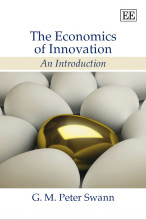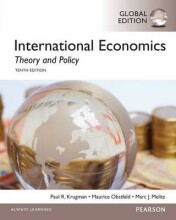Summary: International Economics
- This + 400k other summaries
- A unique study and practice tool
- Never study anything twice again
- Get the grades you hope for
- 100% sure, 100% understanding
Read the summary and the most important questions on International economics
-
Week 5 - Ch. 7 + Ch. 8
This is a preview. There are 19 more flashcards available for chapter 12/03/2017
Show more cards here -
Dynamic increasing returns
When costs fall with cumulative production over time rather than with the current rate of production, then it is a case of ... -
Infant industry argument
The argument for temporary protection of industries to enable them to gain experience -
Week 6 - Ch. 9
This is a preview. There are 7 more flashcards available for chapter 19/03/2017
Show more cards here -
Ad valorem tarrifs
taxes that are levied as a fraction of the value of the imported goods (for example, a 25 percent U.S. tariff on imported trucks) -
Week 8 - Ch. 11 + Ch. 12
This is a preview. There are 8 more flashcards available for chapter 02/04/2017
Show more cards here -
environmental Kuznets curve
Empirical evidence suggests that as economies grow, they initially do increasing damage - but they become more environmentally friendly once they become sufficiently rich. -
Overig/Old exam
This is a preview. There are 6 more flashcards available for chapter 12/04/2017
Show more cards here -
In international trade we distinguish between inter-industry trade and intra-industry trade. Intra-industry trade will tend to dominate trade flows in case of:
Small differences between relative country factor availabilities -
A product is produced in a monopolistically competitive industry with scale economies. If this industry exists in two countries, and these two countries engage in trade one with the other, then we would expect
each of the countries will export different varieties of the product to the other -
A key issue for developing countries is the fact that gains in global value chains (GVCs) are often distributed very unequally, particularly for the activities where integration first take place. Since the 1970s the distribution of gains has become
more unequal, due to more intense competition between developing countries and transfer of technologies leading to cost savings. -
The main redistribution effect of a tariff is the transfer of income from
Domestic consumers to domestic producers -
The effects of trade policy instruments like an import tariff or an export subsidy for a large country differ from the effects of these instruments for a small country
An import tariff will improve the terms of trade of a large country, and an export subsidy will deteriorate the terms of trade of a large country. -
A voluntary exports restraint (VER) is a variant on the import quota. Compared to an import quota or a tariff, a VER is very costly to the importing country because
The rent is earned by foreigners under the VER
- Higher grades + faster learning
- Never study anything twice
- 100% sure, 100% understanding
































